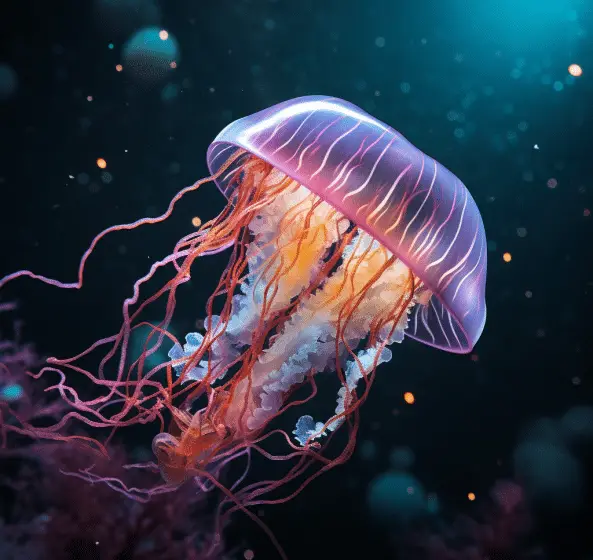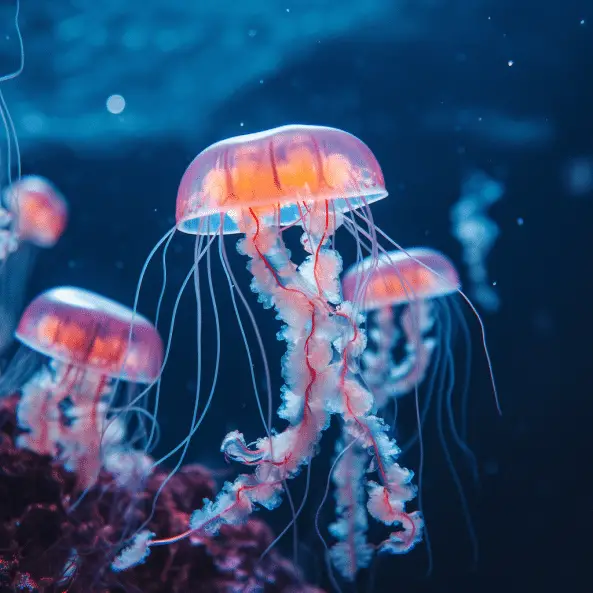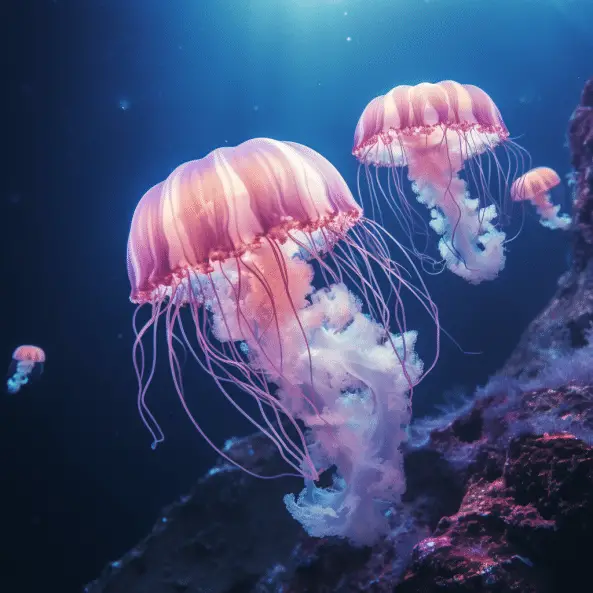Decoding the Mystery: How Do Jellyfish Sleep

Introduction
How Do Jellyfish Sleep: Jellyfish, those fascinating, gelatinous inhabitants of the world’s oceans, often leave us in awe with their otherworldly appearance and graceful, undulating movements. Yet, despite their mesmerizing nature, there is one aspect of their lives that remains a subject of intrigue and mystery: their sleep.
In the realm of marine biology, the concept of sleep in jellyfish has long perplexed scientists and researchers. Sleep, a seemingly universal behavior among animals, is a state of reduced consciousness and responsiveness, often accompanied by distinct changes in brain activity and bodily functions. However, defining and understanding sleep in creatures as different from us as jellyfish has proven to be a complex puzzle.
This enigma arises from the fact that jellyfish lack the typical characteristics associated with sleep in animals with more complex nervous systems. Unlike mammals or birds, jellyfish do not possess a centralized brain. Instead, their neural network is distributed throughout their body, integrated within a decentralized network of nerve cells, or a “nerve net.” This fundamental structural difference raises intriguing questions about how jellyfish experience sleep, if they sleep at all.
Explores the captivating world of jellyfish and the ongoing scientific quest to uncover the mysteries of how they rest or regenerate, shedding light on a remarkable and lesser-known aspect of marine life. As we delve into the depths of this enigmatic realm, we will seek to unravel the secrets of how these ocean drifters find their moments of repose.
Do jellyfish not sleep?
Yes, jellyfish sleep. And the weird part is that jellyfish have no brain and they can still sleep. How is that? Writing this week in the journal, Current Biology, researchers describe how they discovered this unexpected behavior in an upside down jellyfish.
The intriguing question of whether jellyfish sleep remains a subject of ongoing debate in the world of marine biology. Jellyfish, with their decentralized nervous systems and unique biology, challenge conventional definitions of sleep.
Unlike mammals and birds, which exhibit distinct patterns of wakefulness and sleep, jellyfish display a more continuous, subdued state of activity. This has led some researchers to question whether it’s appropriate to use the term “sleep” to describe their behavior.
While jellyfish do exhibit periods of reduced movement and metabolic activity, they lack the characteristic neural signatures of sleep seen in animals with centralized brains. They do not experience rapid eye movement (REM) sleep, and their sleep patterns do not align with the traditional sleep-wake cycles observed in more complex organisms.
The absence of a centralized brain, the decentralized nerve net, and the ambiguity in their sleep-like state have sparked ongoing scientific inquiry. Some scientists argue that the term “rest” might be more suitable than “sleep” when discussing jellyfish behavior.

Where do jellyfish sleep?
He noticed that one genus, Cassiopea, or the upside-down jellyfish, seemed to become less active at night. Cassiopea spends the vast majority of its time sitting upside down on the ocean or tank floor, pulsing its bell about once a second, Abrams told Live Science.
The notion of where jellyfish sleep is intrinsically tied to the enigma of whether they sleep at all. These ethereal creatures lack the conventional sleeping locations and structures found in animals with centralized brains. Without a designated sleeping area or bed, as mammals and birds have, jellyfish present a unique challenge in pinpointing where they might find their moments of repose.
Jellyfish, with their decentralized neural networks, don’t exhibit the localized patterns of neural activity associated with sleep in organisms with centralized brains. Their “sleep-like” states occur in a more diffuse manner throughout their gelatinous bodies, making it challenging to determine if and where they truly sleep. There is no specific place where they retreat for rest, nor a dedicated time for sleep, making their behavior even more enigmatic.
Researchers are still grappling with these questions and attempting to define and understand sleep in creatures as different as jellyfish. Unraveling the mysteries of where, or even how, they rest remains an ongoing journey, highlighting the remarkable adaptations and unique attributes of these captivating denizens of the deep.
Do jellyfish move when sleeping?
To examine if the jellyfish were sleeping, researchers set up cameras and found that they were mostly inactive at night and pulsed 39 times compared to 58 times during the day. The team also found nighttime jellyfish rousing tougher.
Jellyfish sleep movement is a fascinating biological question. Jellyfish behave differently during sleep than most animals.
Due to their decentralized nerve systems and lack of a brain, jellyfish do not undergo muscle atonia, or paralysis, associated with profound sleep in mammals. They may slow down and wander, but they don’t go into complete inactivity like organisms with centralized cerebral control.
Water currents and light affect their movements. This makes me wonder if their activity shifts are sleep or rest. Due to these distinctions, some researchers suggest using “rest” instead of “sleep” to describe jellyfish behavior.
Whether jellyfish move when sleeping challenges our knowledge of sleep and shows how animals have adapted to their environments. Scientists are still studying these fascinating ocean drifters’ complicated behaviours.
How do jellyfish sleep?
They found that jellyfish only pulse 39 times per minute at night, compared to 58 times per minute during the day. Next, the scientists tried to prove that animals had a higher arousal threshold under low activity.
A “nerve net.” of nerve cells spans jellyfish’s gelatinous bodies. This cerebral structure contrasts with mammals, birds, and other sleepers’ centralized brains.
In the absence of a central brain, the definition of sleep in jellyfish becomes more elusive. These creatures do display periods of reduced activity and altered metabolic rates, suggestive of a restful state. However, this state does not conform to the typical patterns of sleep observed in animals with centralized brains.
The absence of rapid eye movement (REM) sleep and a clear sleep-wake cycle in jellyfish challenges conventional sleep criteria. As a result, scientists continue to explore the boundaries of sleep in these gelatinous beings. Unraveling how jellyfish sleep is a journey that forces us to reconsider and expand our understanding of sleep beyond the confines of organisms with centralized nervous systems. It is a testament to the vast and fascinating diversity of life in our oceans.
How do jellyfish live without a heart?
Bloodless, they don’t require a heart to pump it. A nerve net beneath their epidermis sends signals to respond to environmental changes. Their tactile sensitivity means they don’t require a brain to think complexly.
Life on Earth is adaptable, as shown by jellyfish, those beautiful, ethereal organisms that gently cross the oceans. Their capacity to survive without a heart, a key organ that circulates blood in many animals, is fascinating.
Jellyfish have no heart-driven circulatory system like humans and other vertebrates. Instead, they exchange nutrients, gasses, and waste products differently. Because their gelatinous bodies are almost 95% water, chemicals can passively diffuse across their cell layers.
Jellyfish achieve circulation through a simple but effective method called “diffusion.” This process relies on the passive movement of molecules from areas of high concentration to low concentration. Nutrients, oxygen, and waste products simply diffuse in and out of their cells directly through the water that surrounds them.
This beautiful adaptation shows the astonishing diversity of life on Earth and reminds us that there are many methods to distribute important supplies throughout the body. Jellyfish’s reliance on diffusion shows nature’s resourcefulness and capacity to live in many surroundings, even though they have no heart.
When some jellyfish were deprived of sleep?
To find out, the students deprived some of the animals of sleep by pulsing water across them every 20 minutes for 6 hours or 12 hours at night. The jellyfish were not as active the next morning—and were even less so if sleep deprived for 12 hours—but they completely recovered by the next day.
When deprived of sleep, jellyfish exhibit intriguing behavioral changes. Despite their seemingly simplistic nervous system, studies have shown that sleep deprivation can have significant effects on their overall physiology. Unlike mammals, which experience rapid eye movement (REM) and non-REM sleep stages, jellyfish lack the same sleep architecture. Instead, their restful states are characterized by periods of reduced activity.
When subjected to prolonged wakefulness, jellyfish demonstrate altered swimming patterns, showing signs of increased agitation and erratic movements. They may also experience disruptions in their feeding behavior, leading to reduced energy reserves. Interestingly, prolonged wakefulness can potentially interfere with their reproductive processes as well.
The exact mechanisms underlying these responses are still a subject of ongoing research. It’s believed that sleep deprivation may impact the functioning of their basic neural circuits, which control essential behaviors like swimming and feeding. Additionally, disruptions in their circadian rhythms, which regulate their activity patterns over a 24-hour cycle, may play a role.
Understanding how sleep deprivation affects jellyfish not only sheds light on their unique biology but also provides insights into the broader understanding of sleep across the animal kingdom. This research carries implications for understanding the fundamental importance of sleep in various organisms’ overall well-being and survival strategies.
Do all jellyfish glow at night?
It’s true! About 50% of jellyfish can produce light. This amazing ability is called “luminescence” or “bioluminescence.” Jellyfish use bioluminescence mainly to defend against predators.
Not all jellyfish glow at night, but a significant number of them do exhibit bioluminescence. This mesmerizing phenomenon is primarily observed in certain species of jellyfish, particularly those belonging to the family Aequoreidae and some other closely related groups. The bioluminescence is a result of a chemical reaction within specialized cells called photocytes, which contain light-emitting proteins.
These light-emitting proteins, often green or blue in color, produce a soft, ethereal glow when they interact with oxygen. This bioluminescence serves a variety of purposes for jellyfish. It can function as a defense mechanism, deterring predators by creating a sudden burst of light, momentarily blinding or startling potential threats. It can also be used for communication, allowing jellyfish to signal to others of their kind.
However, it’s important to note that not all jellyfish rely on bioluminescence for survival. Many species lack this adaptation altogether and instead employ other strategies for defense and communication. The presence or absence of bioluminescence is just one of the diverse array of features that make jellyfish such a fascinating group of marine creatures.
How do jellyfish know when to rest or become more active?
Jellyfish, despite their seemingly simple anatomy, possess an intricate biological clock that regulates their activity patterns. Unlike vertebrates, they lack centralized brains, yet exhibit a remarkable sensitivity to environmental cues. Light plays a pivotal role in their daily rhythms. Photoreceptors on their bodies detect changes in light intensity, signaling transitions between day and night. During daylight, they tend to be more active, likely to optimize feeding and reproduction.
Jellyfish demonstrate a phenomenon called diel vertical migration, a daily vertical movement within the water column. At dusk, they ascend to surface waters to feed on plankton, capitalizing on the higher concentration available near the surface. As dawn approaches, they descend to deeper, darker waters where they are less visible to predators. This rhythm helps conserve energy and reduces their vulnerability to threats.
The moon also exerts a subtle influence on their behavior. Some studies suggest that moonlight, reflected off the surface of the ocean, may influence the vertical migration of certain jellyfish species. Additionally, they are influenced by changes in temperature, salinity, and even chemical cues from their surroundings.
Intriguingly, the mechanisms underlying these behaviors remain a subject of ongoing research. Studying how jellyfish discern when to rest or become active not only sheds light on their fascinating biology but also deepens our understanding of the complex interplay between organisms and their environments.

Conclusion
We’ve explored jellyfish’s mysterious sleep patterns. This exploration has yielded several intriguing findings, but many questions remain.
Jellyfish’s decentralized brain network makes defining sleep in complicated organisms difficult. Jellyfish have a very different sleep pattern from mammals and birds, which have REM and non-REM cycles. Their resting state is characterized by less activity and a lower metabolic rate, but their lack of a sleep-wake cycle raises questions about their sleep.
Jellyfish sleep, if we can call it that, is very different from sleep in animals with centralized neural systems. Jellyfish sleep may challenge human-centric conceptions of consciousness and rest.
Researchers will continue to study jellyfish sleep to better grasp the deep oceans and appreciate the diversity of life on Earth.



